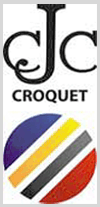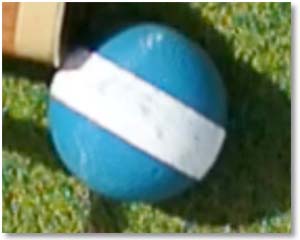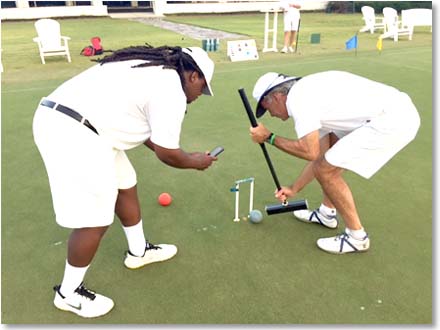
|
Back to |
| The Front Page |
| The Game |
|
Slow-motion video as refereeing aid is simple and easy in Jackson tournament |
|
By Bob Alman with help from Mark Fields and Bob Kroeger photos courtesy of Mark Fields and Bob Kroeger Posted November 14, 2017
|
The human eye, unaided, cannot accurately track such events as double-taps, pushes, and bevel strokes that occur in milliseconds--but slow-motion video can. That is the crux of an issue that has haunted the sport over the last few years, as the technology that allows for instant recording of these mallet events has become more widespread and easier to use. Should this technology be used in croquet as in many other sports? The official guardians of the sport of croquet say they are looking for detailed reports on how it could be used in croquet events. As it turns out, it has been successfully used in two editions of an American Rules tournament in Jackson, Mississippi. This story describes exactly how it was done and records some unexpected benefits.
Tennis does it. Football does it. And Bob Kroeger has become a tireless advocate for employing this technology in croquet. The American pro points out, "Major League Baseball was a longtime holdout, but they are now reviewing video for base calls, the hardest to get correct. If croquet refs are okay with making guesses for many tricky shots--because that's what they are--they need to own up and admit they are guesses."

|
Bob instructed the tournament director on the use of the iPhone (based on the short video he produced on the subject). Bob's agreement with the players and event officials was that any "questionable" shot could now be videoed at the request of any player for their own or the opponents' stroke. Any disagreement on the interpretation of the video Bob would be able to adjudicate quickly, via telephone.
In the 2015 invitational, only a few such recordings were made, and as it turned out, the players had no disagreement on the refereed outcomes, so Bob was not consulted.

|
| Pocahontas Croquet Club's Warwick Alley shoots from the line (the nine-inch mark, in American Rules) in the 2017 Jackson Invitational. |
According to tournament director Mark Fields, that successful experiment was surprisingly easy to do, so they decided to duplicate it in their 2017 event. Kroeger would once again be "on call" for the entire event, and the results turned out to be much the same as in 2015. This year, out of of five video recordings done, only two (both turned out to be faults) were consulted by the local referee. The players agreed in the other cases, and Bob's remote consulting once more was not needed.
"The training time is negligible"
| "CONSULTING REFEREE?" |
|
I scanned an email blast from the USCA on the 2017 Jackson Country Club Invitational listing Bob Kroeger as a "consulting referee." When I asked what it meant, Bob emailed that he was making himself available to be contacted instantly during the tournament to interpret videos of possible striking faults recorded by the local referee--if and when a second opinion was needed--or to provide a rulebook interpretation. .Kroeger has studied slow motion video analysis of the various shots in the sport since 1995 and bought his first slow motion camera in 2009. In 2011, he started using it as an on-site refereeing tool for USCA sanctioned tournaments, providing the striker approved of its use. With the late Ted Prentis he produced a full set of video tutorials for referees of American Rules games utilizing slow motion video throughout as a teaching aid.
|
A general concern is that video-assisted refereeing slows down the game, but according to Fields, "I just didn't see that. A referee trained with slo-mo will have the app open and ready. All he has to do is take his position--as any referee will do--and turn on the phone. In our case, two-thirds of the videos we took required no viewing because both players agreed on what happened.
"The playback on the two videos we consulted was quick. That's because those trained on the slo-mo app know how to rapidly skip past dead-time recording in the video and get right to the relevant section. With his thumb on the app's slide bar, the referee can quickly slide back and forth across the relevant nanosecond and see what actually occurred."
The training time is negligible. Learning the app takes about 15 minutes, and Bob's eight-minute video goes through everything in detail.
Quick playback of the videos
"It just so happened," Mark told me, "that the slo-mo shots filmed at the 2015 tournament turned out to be obvious, after the fact, so even though the slo-mo's were taken, no one felt like they had to be reviewed. That was not an expected outcome, and I would not be surprised if that always happens. Still, the slo-mo's are there if needed."

|
| A single frame of an 1800-frames-per second photograph is one of many frames that reveal a fault which the naked eye is unable to register in just a few milliseconds. |
"So the combination of the slo-mo capability and Bob on standby gave players confidence that justice would prevail. And, good attitude and perception of fairness are certainly desired outcomes!"
Maybe that's the reason the Jackson Country Club uses video from time to time in ordinary club play, as Mark commented: "It's amazing how clearly one can see what actually occurred in a shot. More than once, even the very experienced players have been surprised by the outcome revealed."
Striking faults defined
For the limited purpose of this article, we aren't covering the striking faults that may occur in many types of croquet shots--for example, unhampered croquet strokes, to look for cases of marginal double taps. We're asking whether hoop strokes close to wires should be routinely recorded for viewing, because at present there is a significant element of guesswork in referee decision making--despite all the fine-tuned adjustments made to the Association Croquet laws and to the refereeing guidelines.
According to the official laws of Association Croquet, a fault occurs when...
A. In a croquet stroke, or continuation stroke when the striker's ball is touching another ball, allows the mallet to contact the striker's ball visibly more than once; or
B. in any other stroke, allows the mallet to contact the striker's ball more than once; or
C. in any stroke, allows the mallet to remain in contact with the striker's ball for an observable period.
What does "visibly" mean?
The official commentary defines 'visibly" as "capable of being seen by someone with normal eyesight standing in a good position to observe the stroke. But aren't the observers' "normal eyesight(s)" subject to differing interpretations, each bearing the hallmark of the individual observer's cognitive ability--just as the most honorable player's visual interpretation can be subconsciously bent by the circumstances of the game?
I corresponded with Ian Vincent, the chairman of the World Croquet Federation's five-person International Laws Committee, about the current status of video-aided refereeing. According to Vincent, "the observable duration of multiple contacts" determines what actually constitutes a fault under the interpretation above, "recognizing that those contacts occur over a brief time interval in most croquet strokes. So although high speed photography may show that there were multiple contacts in a croquet stroke, that does not necessarily mean that a fault was committed"--according to current interpretation of the laws.
Seeing clearly what actually happened
| HOW SHOULD THE WCF ADDRESS THIS CAN OF WORMS? |
|
Martin French, former Secretary-General of the World Croquet Federation, has closely followed the "slow motion" issue for more than a decade, since the Croquet Association's own study on slow motion was begun in 2006. That study led to the introduction of the words "visibly" and "observable" into the AC fault rules--approximations which describe "what can be seen with the naked eye" but can never be translated into a precise number of nanoseconds. That study showed clearly that even some "normal" croquet strokes, when viewed in slow motion, included a double tap. French asks, "So do we change the standard by which such faults are judged, or do we accept that many normal croquet strokes should in fact be outlawed?" He has suggested to the WCF that setting up a study to consider exactly these issues would be worthwhile, to adjust the rules accordingly and guide video-referees. Perhaps now is the time.
|
It's hard to imagine a time when any available valid "evidence" should be outlawed, so the ultimate question now becomes, "How soon will video-aided refereeing become a normal part of the sport at significant events?" The answers I've gotten have ranged from five years to never.
Resistance to change seems especially vociferous in England in 2017, when such advisements as the following are sent out by event managers to potential referees: "All qualified Referees may act in regard to all matters covered by [refereeing] Regulations R2 & R7. Other players may act as umpires only under Regulation R7. If you are a qualified referee, please indicate this on the list of players. Video evidence will not be permitted."
Although many officials throughout the world are worried about the extra time and bother they believe attaches to use of slow-motion video to aid refereeing, they do strongly support the technology for use in training referees.
"Amateur" does not mean "lax"
Some may argue that because croquet really is an amateur sport--that is, one that does not offer prizes or cash sufficient to inspire someone to take it up--the standards can therefore be less rigid than for a "professional" sport. But "amateur" does not mean "lax."
Perhaps the most vocal champion of croquet as an amateur sport is also among the strongest advocates of tough standards for competition: the fast courts and unforgiving hoops that make the game more difficult and provide conditions for the highest number of "hit-in" attempts in a game, helping to ensure that the most skilled player wins.
Chris Clarke of New Zealand wrote to me, "I am in favour of developing a set of guidelines relating to the use of slo-mo cameras in both AC and GC events. Currently, whilst we have the potential to use such equipment, we have no agreement as to what level of 'proof' needs to be provided. For example, a referee watches a shot. I believe that the guidelines should operate a bit like American Football.
"a. The referee gives an initial verdict (clean/fault); b. If either player disagrees, the video is reviewed and only in the case where there is CLEAR evidence that the initial verdict is wrong, the decision is reversed.
"From that stage, I would encourage the use of video in any event where the equipment and skill to use it exists. I would ideally like all World Croquet Federation events to have the capacity to use video technology within five years."

|
| Joe Moore, Director of Croquet, uses an iPhone to record a potential faulting situation by Mark Fields. Joe took six videos over the course of the three-day tournament. Four were obvious calls and required no replay. The two reviewed to determine whether a rules violation had occurred both resulted in a fault call. |
In the meantime, the different national associations are free to set their own standards on video refereeing--or not.
The Jackson Country Club Invitational--with a little encouragement from Bob Kroeger--has shown that using video technology is a lot easier than one might imagine, and it yields benefits beyond the mere recording of physical events--in the confidence of the players and the general atmosphere of fairness and sportsmanship.
Even in a small tournament in an amateur sport, it's surprisingly easy to create an environment in which the players are certain that rigorous standards will be uniformly applied, and that the results will be fair and just.
|
RULE 28 OF THE OFFICIAL LAWS OF ASSOCIATION CROQUET
The official laws are in continuous flux in response not only to refinements in the game but also to new technologies, making many fine distinctions in declaring precisely which characteristics of which strokes will be punishable by penalty. To be certain of avoiding mischaracterizing any of the current rules and definitions, we have decided to publish here a major chunk of the Laws that may or may not in time be subject to revision with updated standards of refereeing allowing and even encouraging the admission of slow motion video in judging faults.
|